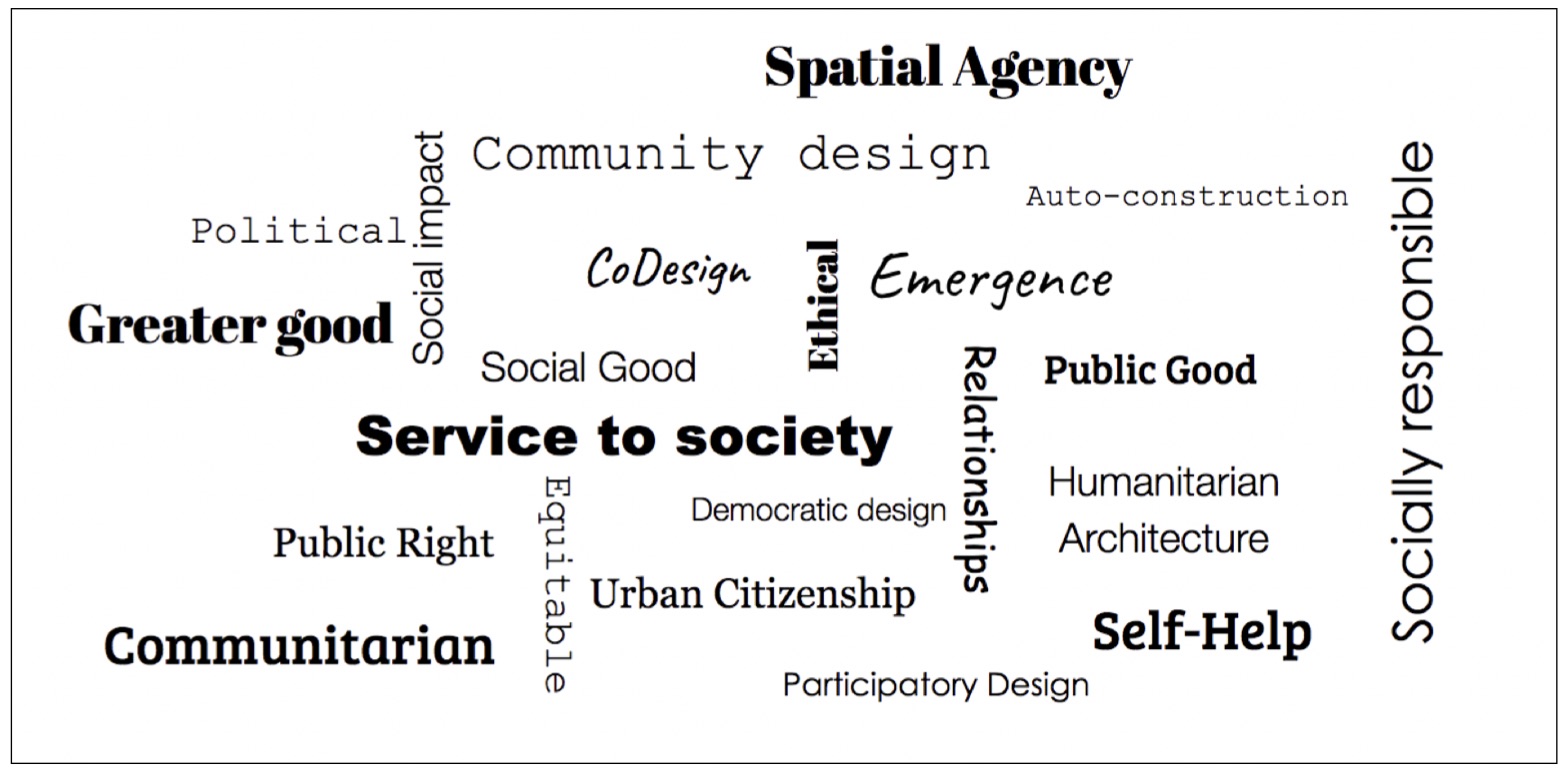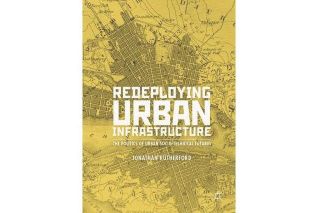
www.buildingsandcities.org/insights/reviews/routledge-companion-architecture-social-engagement.html
The Routledge Companion to Architecture and Social Engagement

Edited by Farhan Karim. Routledge, 2018, ISBN: 9781138889699
Carin Combrinck (University of Pretoria) welcomes this book for its timeliness, sense of urgency and advancement of a missing pillar of sustainability. Redefining architecture for its social engagement and public contribution will have important implications for practice, teaching and research.
It is highly meaningful to read the Routledge Companion to Architecture and Social Engagement in this particular moment in history, when half of humanity is confined to their homes during the Covid-19 pandemic. Nils Gore's section on Reconceiving Professionalism especially strikes a chord:
"In 2011 I heard Thomas Fisher, then dean of the University of Minnesota College of Design, give a talk where he briefly recounted the establishment of the public health profession, as distinct from that of medicine, and in that talk, suggested that something similar ought to happen for what he called 'public architecture' (and what we may now have settled on calling 'public interest design'), meaning the design of the built world that needs to happen outside the bounds of the bespoke project on the individual piece of land which typifies the cast majority of architects' work. He used the example of a pandemic which might start in a squatter settlement in the developing world, incubating and flourishing because of the lack of adequate infrastructure, and that rapidly spreads around the world, as a result of the mobility of all people everywhere. The costs of dealing with a pandemic would be enormous, and might be prevented with a much less costly and better-designed housing settlement with adequate infrastructure. Fisher argued that the costs of providing public design services would be a better value proposition than waiting for the outbreak to occur and then dealing with the catastrophic outcomes. This is but one example of a public interest project. We can include community design issues such as alternate transit systems, energy systems, the food system, design for equity, racial and social justice, affordable housing, and design for public awareness as other projects needing attention." (Gore 2018: 122)
A sense of haste pulsates throughout the book, with a shared call to action that seems to unite the myriad of voices speaking out from these voluminous pages. The book constitutes a critical mass of scholars drawn from different countries who are united to redefine architecture as a discipline of social purpose. The book confirms that we are not alone: scholars, educators and practitioners argue the importance of looking beyond the self-referential limitations of our discipline. It successfully explains there is more to be done and other ways of getting it done than merely focusing on the product of architecture. This includes a greater emphasis on the relationships and complexity involved in the processes of design, construction and appropriation of space, bearing in mind the consequences and impacts of these fundamentally political and cultural processes.
The book suggests that socially engaged architecture is important and relevant, from its deeply philosophical considerations through to its teaching and practice. No stone has been left unturned here, with every notable reference included to support a comprehensive and rigorous discourse. Even the heroes of this genre have been regarded under the magnifying lens of critical contextualisation thereby enabling the reader to understand the substantive historical grounding on which to build a continuing body of scholarship and praxis.
This book is a comforting and calming experience to read during an anxious time. The curation of the multiple voices and perspectives in this volume will challenge the reader's perceptions and imagination. It may also confirm some readers' earlier suspicions and propositions. The book is uncannily appropriate to its time and promises to become one of the most important contributions to a discourse that needs to move from the margins to the mainstream with utmost urgency.
The book's structure is easily accessible and logical, with a chronological approach that makes it simple to follow and to reflect back on the work. The organisation considers the philosophical discourse; historical perspective; questions of ethics and legitimacy; professional and educational implications, illustrated by way of practical applications of projects at varying scales.
This organisation frames the main themes in the book, which are captured in the wordcloud below. The themes converge around a paradigm shift away from individualist concepts of control and self-interest towards a collective view of empathy and service to society. Such service is considered from a perspective of agency and respect for local narratives and power structures, where the notion of 'expertise' is redefined to include all participants as valuable collaborators in the co-creation of the built environment. Epistemic diversity becomes more highly valued in this paradigm, where a variety of knowledge systems may serve to address the complex challenges we are all facing.

It is clearly the editor's intent to offer a comprehensive encyclopaedia of the current discourse on socially engaged architecture. Without a doubt, the book has succeeded in this ambition and promises to become an authoritative voice and source of reference to anyone already interested in this field or hoping to familiarise themselves with it. The wide range of critical viewpoints leaves the reader in no doubt as to the challenges and opportunities that are involved in all aspects of this genre in architecture, extending by its nature an open invitation to continue and contribute to the evident fluidity of the discourse.
This book offers a rich platter of thought for researchers to test, to build on, to compare and to frame continuing investigations. Provocations and examples of successes and failures may be referred to with ease to situate alternative hypotheses. From heavy-handed interventions in Zanskar, India (refer to Chapter 9 by Carey Clouse) to the deeply thought-provoking reflections on healing after the Rwandan genocide (refer to chapter 17 by Yutaka Sho), the basis has been established from which to identify a well-grounded normative position. Policy makers and practitioners will find answers and suggestions that may serve to support meaningful shifts in direction, as the work presented is rigorous and steeped in credibility and gravitas. For educators, the book is a gift because it provides a well-considered, well-rounded and clear demonstration of a substantial, relevant and significant body of thought.
Introducing and framing the
professional distinction of Public Interest Design (PID) (refer specifically to
Chapter 25 by Joongsub Kim) promises a truly useful and meaningful opportunity
to resolve some of the tensions within the academic accreditation conundrum in
which this discourse often finds itself. By framing the collective endeavour in
this way, some of the institutional resistance that is often mentioned in the
book may be overcome. As part of the need to move beyond the traditionally held
margins, PID may lead to greater impact on the profession and by implication,
on society.
Not all stakeholders will be interested in reading the book from cover to cover, nor is it necessary to do so. It is possible for stakeholders to choose what is of value to them and have a reliable resource available to support their cause in arguing for greater social engagement in architecture. It is therefore my view that everyone who is concerned with a process of social engagement ought to have a copy on the shelf for continued reference. The publisher's price (ca.£152) may be considered contrary to the socially inclusive message in the book.
This book is a trove of inspiration and confirmation. It successfully argues and demonstrates an alternative pathway for architects and architectural students to make more meaningful contributions to society. The need to do so is reflected in the words of the current International Union of Architects (UIA) president, Thomas Vonier, whose call on 6 April 2020 has recently gone out:
"When architects created the UIA in 1948, the world was barely past the worst cataclysm in memory: World War II. The human toll of that war was horrific, and it left many cities and economies in shambles... Today, just as in 1948, architects must unite in service to society, bringing global perspective and vision. As the profession's international organisation, it is our role to highlight relevant research, promote information sharing and advocate for sound policies."
Latest Peer-Reviewed Journal Content
A framework for 1.5°C-aligned GHG budgets in architecture
G Betti, I Spaar, D Bachmann, A Jerosch-Herold, E Kühner, R Yang, K Avhad & S Sinning
Net zero retrofit of the building stock [editorial]
D Godoy-Shimizu & P Steadman
Co-learning in living labs: nurturing civic agency and resilience
A Belfield
The importance of multi-roles and code-switching in living labs
H Noller & A Tarik
Researchers’ shifting roles in living labs for knowledge co-production
C-C Dobre & G Faldi
Increasing civic resilience in urban living labs: city authorities’ roles
E Alatalo, M Laine & M Kyrönviita
Co-curation as civic practice in community engagement
Z Li, M Sunikka-Blank, R Purohit & F Samuel
Preserving buildings: emission reductions from circular economy strategies in Austria
N Alaux, V Kulmer, J Vogel & A Passer
Urban living labs: relationality between institutions and local circularity
P Palo, M Adelfio, J Lundin & E Brandão
Living labs: epistemic modelling, temporariness and land value
J Clossick, T Khonsari & U Steven
Co-creating interventions to prevent mosquito-borne disease transmission in hospitals
O Sloan Wood, E Lupenza, D M Agnello, J B Knudsen, M Msellem, K L Schiøler & F Saleh
Circularity at the neighbourhood scale: co-creative living lab lessons
J Honsa, A Versele, T Van de Kerckhove & C Piccardo
Positive energy districts and energy communities: how living labs create value
E Malakhatka, O Shafqat, A Sandoff & L Thuvander
Built environment governance and professionalism: the end of laissez-faire (again)
S Foxell
Co-creating justice in housing energy transitions through energy living labs
D Ricci, C Leiwakabessy, S van Wieringen, P de Koning & T Konstantinou
HVAC characterisation of existing Canadian buildings for decarbonisation retrofit identification
J Adebisi & J J McArthur
Simulation and the building performance gap [editorial]
M Donn
Developing criteria for effective building-sector commitments in nationally determined contributions
P Graham, K McFarlane & M Taheri
Reimagining circularity: actions for optimising the use of existing buildings
R Lundgren, R Kyrö, S Toivonen & L Tähtinen
Effective interdisciplinary stakeholder engagement in net zero building design
S Vakeva-Baird, F Tahmasebi, JJ Williams & D Mumovic
Metrics for building component disassembly potential: a practical framework
H Järvelä, A Lehto, T Pirilä & M Kuittinen
The unfitness of dwellings: why spatial and conceptual boundaries matter
E Nisonen, D Milián Bernal & S Pelsmakers
Environmental variables and air quality: implications for planning and public health
H Itzhak-Ben-Shalom, T Saroglou, V Multanen, A Vanunu, A Karnieli, D Katoshevski, N Davidovitch & I A Meir
Exploring diverse drivers behind hybrid heating solutions
S Kilpeläinen, S Pelsmakers, R Castaño-Rosa & M-S Miettinen
Urban rooms and the expanded ecology of urban living labs
E Akbil & C Butterworth
Living with extreme heat: perceptions and experiences
L King & C Demski
A systemic decision-making model for energy retrofits
C Schünemann, M Dshemuchadse & S Scherbaum
Modelling site-specific outdoor temperature for buildings in urban environments
K Cebrat, J Narożny, M Baborska-Narożny & M Smektała
Understanding shading through home-use experience, measurement and modelling
M Baborska-Narożny, K Bandurski, & M Grudzińska
Building performance simulation for sensemaking in architectural pedagogy
M Bohm
Beyond the building: governance challenges in social housing retrofit
H Charles
Heat stress in social housing districts: tree cover–built form interaction
C Lopez-Ordoñez, E Garcia-Nevado, H Coch & M Morganti
An observational analysis of shade-related pedestrian activity
M Levenson, D Pearlmutter & O Aleksandrowicz
Learning to sail a building: a people-first approach to retrofit
B Bordass, R Pender, K Steele & A Graham
Market transformations: gas conversion as a blueprint for net zero retrofit
A Gillich
Resistance against zero-emission neighbourhood infrastructuring: key lessons from Norway
T Berker & R Woods
Megatrends and weak signals shaping future real estate
S Toivonen
A strategic niche management framework to scale deep energy retrofits
T H King & M Jemtrud
Generative AI: reconfiguring supervision and doctoral research
P Boyd & D Harding
Exploring interactions between shading and view using visual difference prediction
S Wasilewski & M Andersen
How urban green infrastructure contributes to carbon neutrality [briefing note]
R Hautamäki, L Kulmala, M Ariluoma & L Järvi
Implementing and operating net zero buildings in South Africa
R Terblanche, C May & J Steward
Quantifying inter-dwelling air exchanges during fan pressurisation tests
D Glew, F Thomas, D Miles-Shenton & J Parker
Western Asian and Northern African residential building stocks: archetype analysis
S Akin, A Eghbali, C Nwagwu & E Hertwich
Join Our Community

The most important part of any journal is our people – readers, authors, reviewers, editorial board members and editors. You are cordially invited to join our community by joining our mailing list. We send out occasional emails about the journal – calls for papers, special issues, events and more.
We will not share your email with third parties. Read more



Latest Commentaries
COP30 Report
Matti Kuittinen (Aalto University) reflects on his experience of attending the 2025 UN Conference of the Parties in Belém, Brazil. The roadmaps and commitments failed to deliver the objectives of the 2025 Paris Agreement. However, 2 countries - Japan and Senegal - announced they are creating roadmaps to decarbonise their buildings. An international group of government ministers put housing on the agenda - specifying the need for reduced carbon and energy use along with affordability, quality and climate resilience.
Building-Related Research: New Context, New Challenges
Raymond J. Cole (University of British Columbia) reflects on the key challenges raised in the 34 commissioned essays for Buildings & Cities 5th anniversary. Not only are key research issues identified, but the consequences of changing contexts for conducting research and tailoring its influence on society are highlighted as key areas of action.